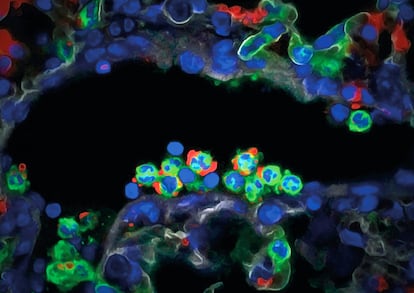The human body has 1.8 trillion cells dedicated to defending it
For the first time, a study has measured the size of the immune system: if it were an organ, it would weigh more than a kilo and represents 0.2% of all human cells

To adequately defend ourselves against any pathogen that may enter our body, the cells of the immune system must be in continuous movement, so that they carry out surveillance even in the remotest parts of our body. Non-specific immune cells (granulocytes, macrophages, dendritic cells, NK cells and mast cells, among others) are dispersed, but the specific cells involved are largely found in the secondary immune organs. This is where the presentation of the antigen and the stimulation of lymphocytes capable of recognition takes place.
The dispersed nature of the immune system raises three interesting questions that are very difficult to answer. How many immune cells are there in the human body? How many do we have in each organ? And what is their total weight?
A recently published study tries to answer these questions. Since it is impossible to count the cells one by one, the researchers opted for a three-pronged strategy.
Firstly, they carried out an extensive bibliographic review, collecting all available data regarding the presence of immune cells in tissues. Specifically, they tried to collect the different cell densities, that is, the number of cells per gram of tissue, in addition to histological data.

Second, they used multichannel cell imaging, a new technology that allows many biomarkers to be identified simultaneously. This allows complex tissues and cellular phenotypes to be recognized.
And, thirdly, they used deconvolution based on methylation patterns. Cellular deconvolution consists of estimating — using computational techniques — the proportion of cells that exist in a specific tissue. As each cell has a characteristic methylation pattern, the combination of both techniques allows researchers to identify the different cell subpopulations present in a sample.
Billions of cells
The use and cross-validation of these three techniques has allowed the authors to reach the conclusion that a prototypical person — historically characterized as a 20-30 year old male, weighing 73 kilos and standing 176 centimeters tall — has a total of 1.8x10¹² cells. That is, almost two billion (1.8 billion) cells. That’s a lot, especially if we take into account that muscle and adipose tissues constitute 75% of total body mass, but that, being very large cells, only represent 0.2% of all the cells in our body.
Most immune cells are located in two places: bone marrow and lymphatic tissue. Bone marrow contains 40% of that astronomical number of cells — with neutrophil accounting for 80%. A total of 39% of immune cells are located in the lymphatic tissue, with a significant predominance of lymphocytes. The skin, lungs and gastrointestinal tract each contain a modest 3% of the total.
Macrophages, which are poorly represented in many tissues, gather in the liver, where they represent 70% of the immune cells in this organ. Thirty percent of all NK cells also reside in the organ. Based on this, it is deduced that the liver plays an important role in the body’s immune response, especially with regard to eliminating antigens that have entered through the digestive tract.
More than a kilo
The study also offers some surprising discoveries. For example, if the immune system were a solid organ, it would weigh 1.2 kilos. Or, in other words, it would have almost the same weight as the liver, which is considered the largest and heaviest organ.
Of those 1.2 kilos, macrophages — which represent just 15% of the total immune cells — would weigh 600 grams. And the even scarcer dendritic cells would weigh another 100 grams. This is due to the large size of these two types of cells. In contrast, lymphocytes would weigh less than 200 grams, despite their high percentage, because of their small size. The mass of immune cells contained in the bone marrow and lymphatic tissue is the largest of all (30% and 27% of the total, respectively).
However, the biggest surprise concerns the gastrointestinal tract. Contrary to what was thought, only 3% of the total immune cells are located there, much less than expected. And it is also surprising that around 70% of the total plasma cells, which produce antibodies, are found in the digestive tract.
Looking towards the future
This study is significant because it combines multiple approaches to solve problems that cannot be approached directly, and that could be of interest to determine the number of cells belonging to other lineages.
More importantly, by giving us a global distribution of the cells of the immune system, we can better understand their global organization and, therefore, how to modulate it to design innovative therapies.
Ignacio J. Molina Pineda de las Infantas, professor of Immunology, Biomedical Research Center, University of Granada.
This article was originally published in Spanish in The Conversation.
Tu suscripción se está usando en otro dispositivo
¿Quieres añadir otro usuario a tu suscripción?
Si continúas leyendo en este dispositivo, no se podrá leer en el otro.
FlechaTu suscripción se está usando en otro dispositivo y solo puedes acceder a EL PAÍS desde un dispositivo a la vez.
Si quieres compartir tu cuenta, cambia tu suscripción a la modalidad Premium, así podrás añadir otro usuario. Cada uno accederá con su propia cuenta de email, lo que os permitirá personalizar vuestra experiencia en EL PAÍS.
¿Tienes una suscripción de empresa? Accede aquí para contratar más cuentas.
En el caso de no saber quién está usando tu cuenta, te recomendamos cambiar tu contraseña aquí.
Si decides continuar compartiendo tu cuenta, este mensaje se mostrará en tu dispositivo y en el de la otra persona que está usando tu cuenta de forma indefinida, afectando a tu experiencia de lectura. Puedes consultar aquí los términos y condiciones de la suscripción digital.
More information
Últimas noticias
Maduro pleads not guilty before the federal court in New York: ‘I am still the president of Venezuela’
A new test can detect Alzheimer’s from a finger prick
UN team enters Sudanese city of El Fasher after paramilitary massacre: ‘It’s like a ghost town’
A recipe for resistance: Indigenous peoples politicize their struggles from the kitchen
Most viewed
- Gilles Lipovetsky: ‘If you want to live better and fall in love, take Prozac, don’t look to philosophy’
- Alain Aspect, Nobel laureate in physics: ‘Einstein was so smart that he would have had to recognize quantum entanglement’
- Maduro’s downfall puts China’s relationship with Venezuela to the test
- Why oil has been at the center of Venezuela-US conflicts for decades
- Alvin Hellerstein, a 92-year-old judge appointed by Bill Clinton, to preside over Maduro’s trial in New York










































